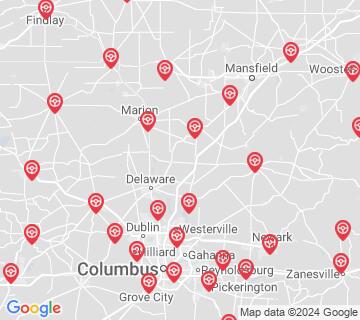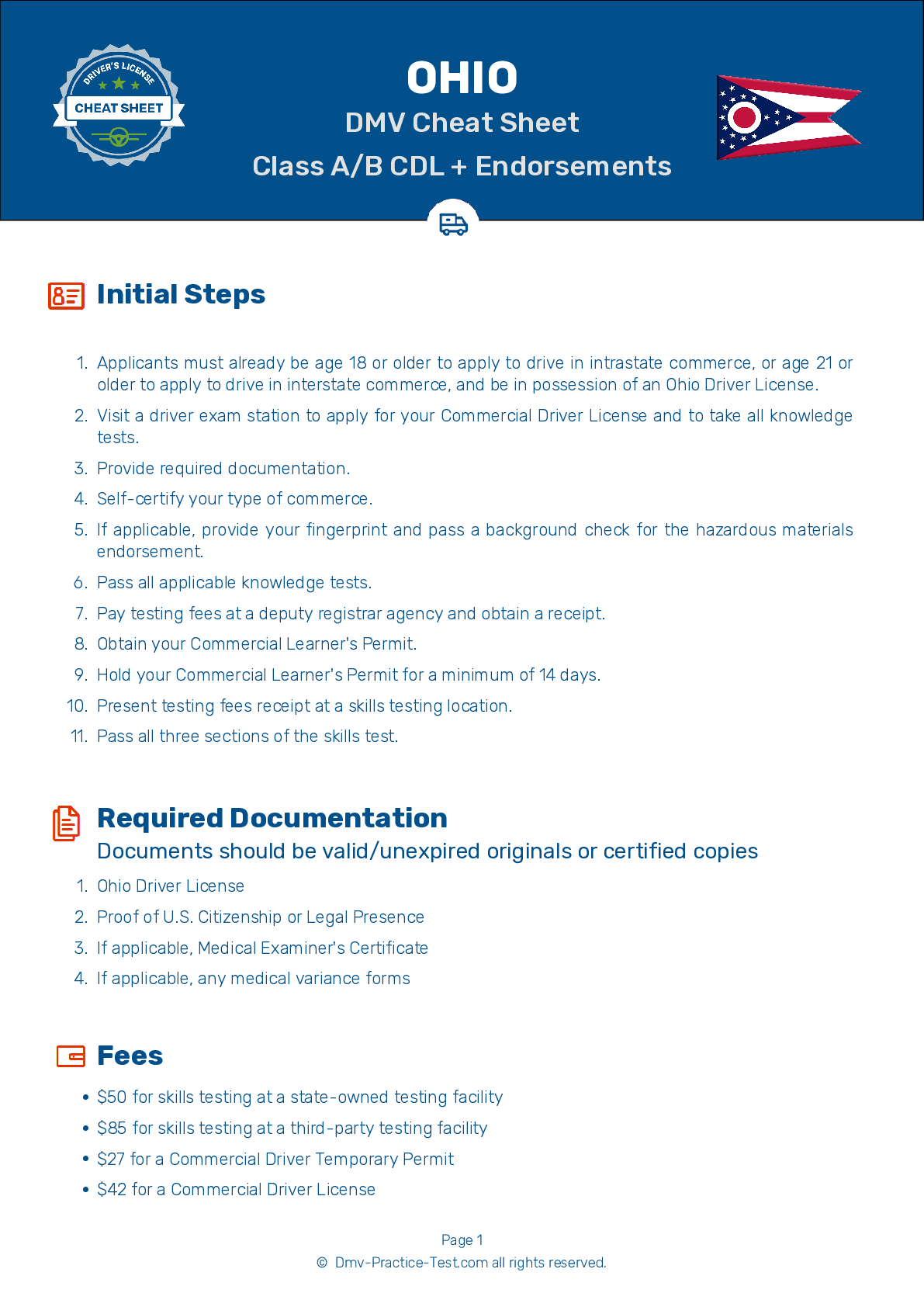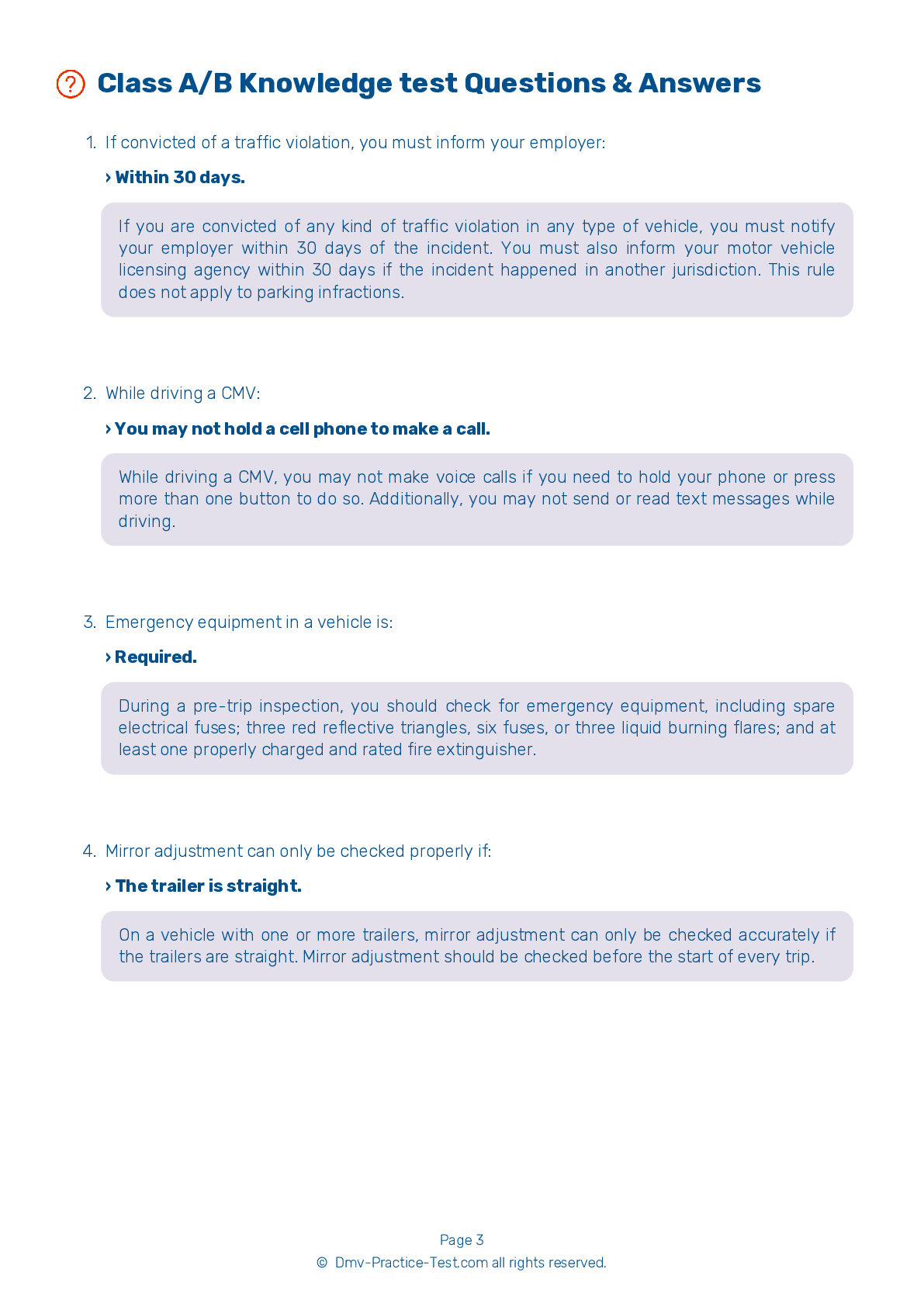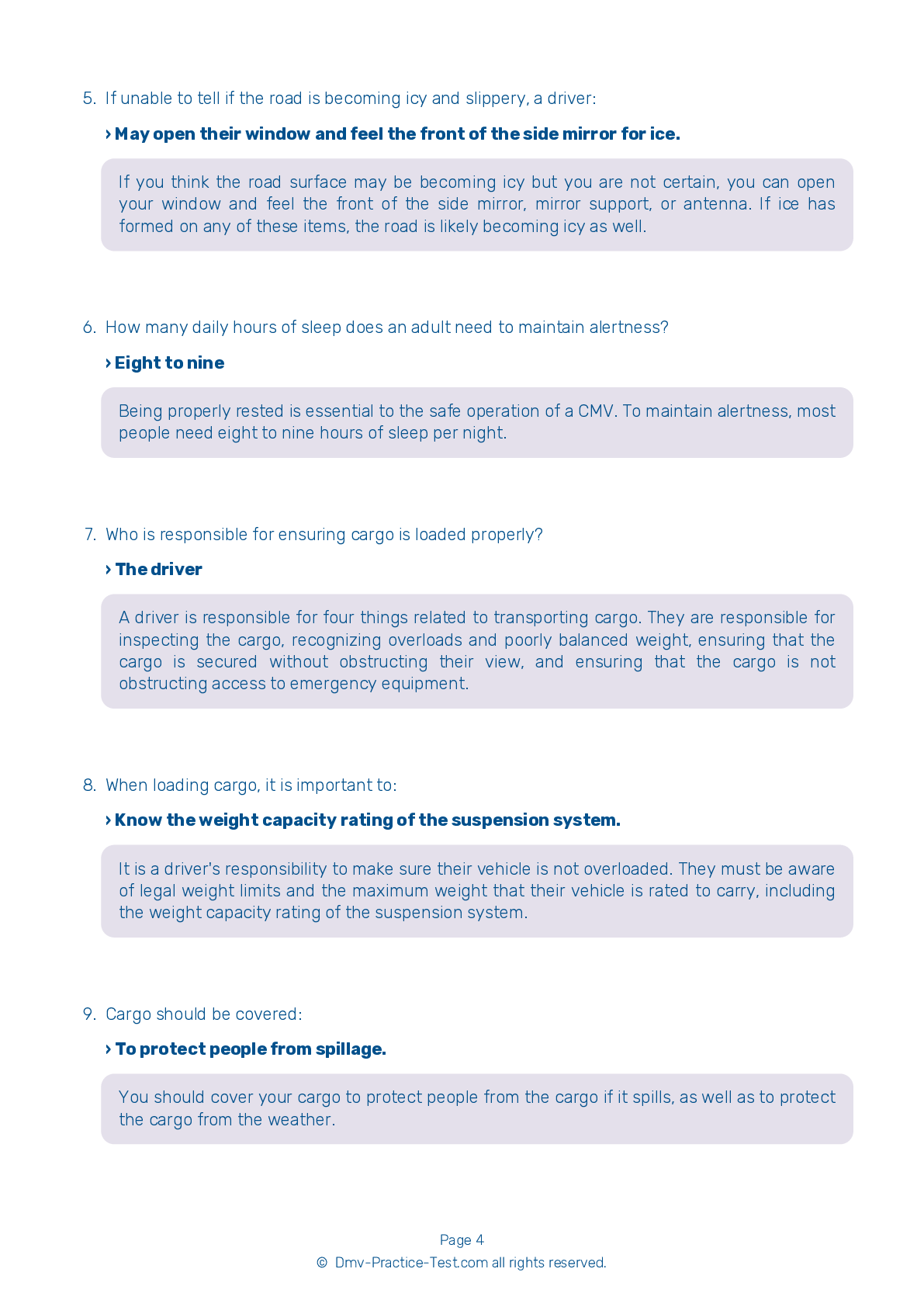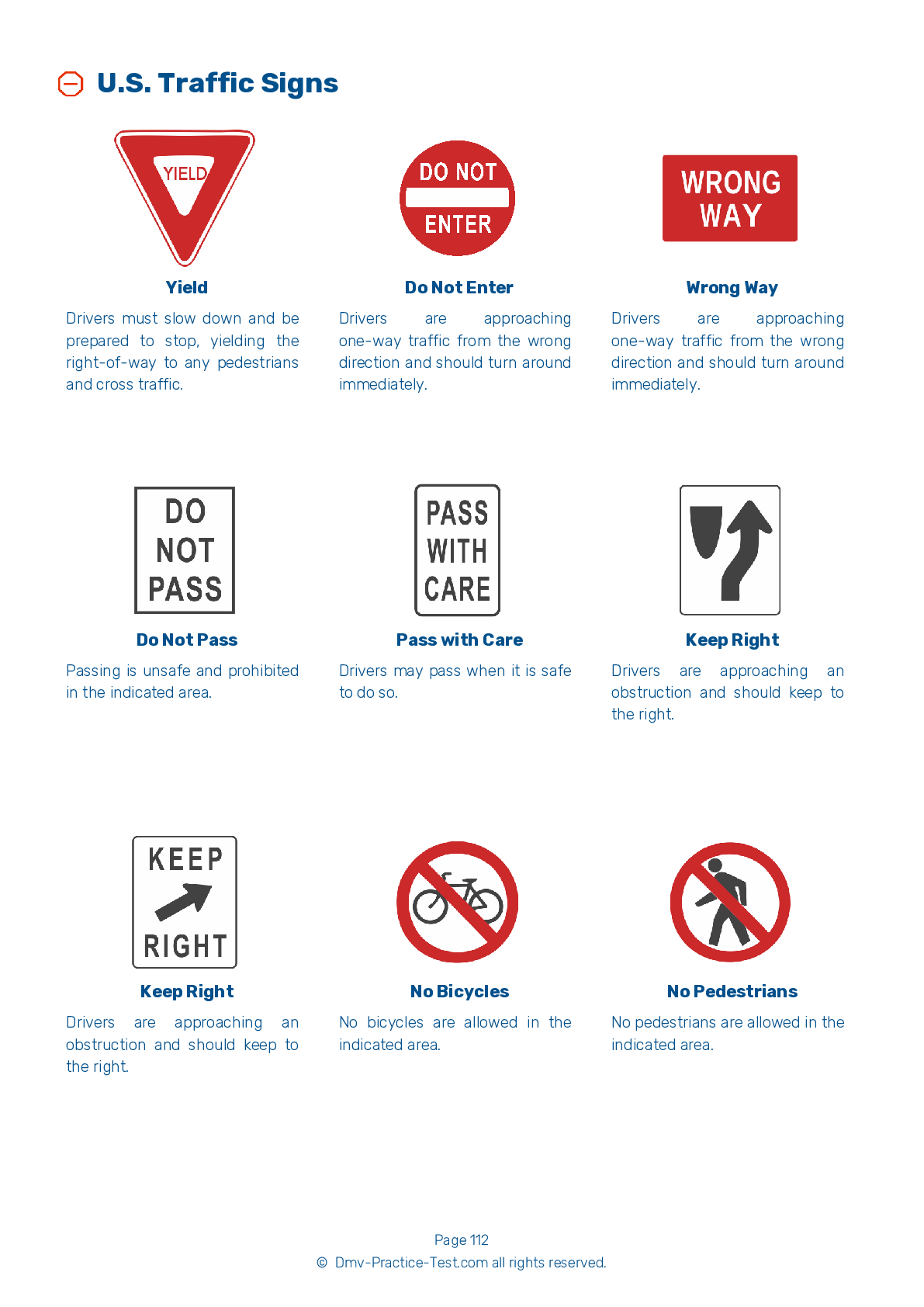Knowledge Test Class B #1
Class B Driving Test | Ohio 2025 #1 Page 7 of 7
Train for FREE online with our Ohio class B license test. The official exam test consists of several obligatory parts, with all of them checking your knowledge of different blocks of road rules. If you need to obtain a OH CDL class B permit in 2025, practice as much as possible. Free sample tests published on our website will help you check and improve your knowledge and boost your grades. Please bear in mind that CDL class B requirements may vary from state to state.
50
40
20
43 . Which of the following determines your blood alcohol concentration (BAC)?
The main factors that determine a person's blood alcohol concentration (BAC) are how much alcohol has been consumed, how quickly it was consumed, and the person's body weight.
44 . How much distance will an air brake-equipped vehicle need to come to a complete stop if it is traveling at 55 mph under ideal driving conditions?
A vehicle's total stopping distance is made up of perception distance, reaction distance, brake lag distance, and braking distance. With all of these factors included, an air brake-equipped vehicle traveling at a speed of 55 mph under ideal driving conditions will need approximately 450 feet to come to a complete stop.
45 . How many daily hours of sleep does an adult need to maintain alertness?
Four to five
Being properly rested is essential to the safe operation of a CMV. To maintain alertness, most people need eight to nine hours of sleep per night.
46 . When completing a conventional parallel parking maneuver, you should:
You may be asked to complete a conventional parallel parking maneuver into a parking space that is to the right of your vehicle. You should drive past the parking space before backing into it while bringing the rear of your vehicle as close to the rear of the space as possible. Your vehicle should be completely within the boundaries of the space.
47 . When traveling on a downgrade, your vehicle will:
Gravity causes a vehicle's speed to increase when traveling on a downgrade. Adjust your speed before reaching a downgrade.
48 . Water that has collected on a roadway can cause:
The risk of hydroplaning begins when water has collected on the surface of a road.
49 . During the vehicle inspection test, you will be asked to:
During the vehicle inspection test, you will be asked to do a complete inspection of your vehicle. You will need to explain what you are inspecting and why.
50 . While driving, if you notice anything that affects safety or could lead to mechanical problems, you should:
After finishing a day of driving, you may have to complete a written report on the condition of your vehicle. Be sure to mention anything that could affect safety or lead to mechanical breakdown.
Search the best driving school in your neighbourhood
2025 Ohio | Frequently Asked Questions
To secure a CDL Doubles/Triples endorsement in Ohio, you must first have a Commercial Driver's License (CDL). You then need to pass the Doubles/Triples Knowledge test. After passing the test, you can apply for the endorsement at your local Bureau of Motor Vehicles (BMV). Remember, driving experience with large trucks is highly recommended before applying.
To obtain a CDL Doubles/Triples license, you first need a valid Commercial Driver's License (CDL). Then, study the Doubles/Triples section of your state's CDL manual. After studying, you'll need to pass a written knowledge test at a local Bureau of Motor Vehicles (BMV). The test covers topics like coupling and uncoupling, inspecting doubles and triples, and handling.
While Ohio doesn't explicitly require specialized training for a CDL Doubles/Triples endorsement, it's highly recommended. Experience with large trucks is beneficial as handling double/triple trailers is complex. Preparing for the Doubles/Triples Knowledge test, which includes questions on coupling and uncoupling, inspecting doubles and triples, and checking air brakes, will also require some form of study or training.
Yes, to obtain a CDL Doubles/Triples endorsement in Ohio, you are required to pass the Doubles/Triples Knowledge test. This test focuses on specific areas like coupling and uncoupling, inspecting doubles and triples, and checking air brakes. It's crucial to study these areas thoroughly to successfully pass the exam.
The CDL Doubles/Triples endorsement test in Ohio is a written knowledge test, not a skills test. Therefore, you won't need to showcase any physical maneuvers. However, you'll need to demonstrate understanding of topics like coupling and uncoupling, inspecting doubles and triples, checking air brakes, and driving safely with more than one trailer.
No, it is not permissible to operate double/triple trailers without a valid CDL Doubles/Triples endorsement in Ohio. Operating such vehicles without the correct endorsement could result in fines, penalties, and potentially the suspension of your CDL. It's important to obtain the correct endorsements for the type of vehicle you're operating.
You can add the CDL Doubles/Triples endorsement to your existing commercial driver's license. You don't need to start a new application for a separate license. However, you will need to pass the Doubles/Triples Knowledge test and pay any associated fees to have this endorsement added to your current CDL.
Yes, there are limitations for drivers with a CDL Doubles/Triples endorsement. Drivers must strictly adhere to weight limits for double/triple trailers. They must also ensure proper coupling and uncoupling procedures, inspect trailers, and manage safe driving conditions. Additionally, certain highways or roads may prohibit the use of double/triple trailers due to their size.
In Ohio, the maximum weight for a vehicle with a double trailer is 80,000 pounds and the maximum length is 75 feet. For triple trailers, the maximum weight is also 80,000 pounds, but the length can vary. However, triples are rarely used due to their size and are restricted on many highways. Always check with local regulations for specific restrictions.
Yes, Ohio has specific safety guidelines for driving double/triple trailers. Drivers must understand how to couple and uncouple correctly, and how to inspect their vehicles. They must also know how to manage the space around their vehicle, control speed, and maneuver in different situations. Following these guidelines helps ensure the safety of everyone on the road.
